Analysis of Equality Act 2010
VerifiedAdded on 2023/01/19
|8
|3691
|92
AI Summary
This analysis explores the Equality Act 2010 and its implications for employers in terms of discrimination and reasonable adjustments for disabled employees.
Contribute Materials
Your contribution can guide someone’s learning journey. Share your
documents today.
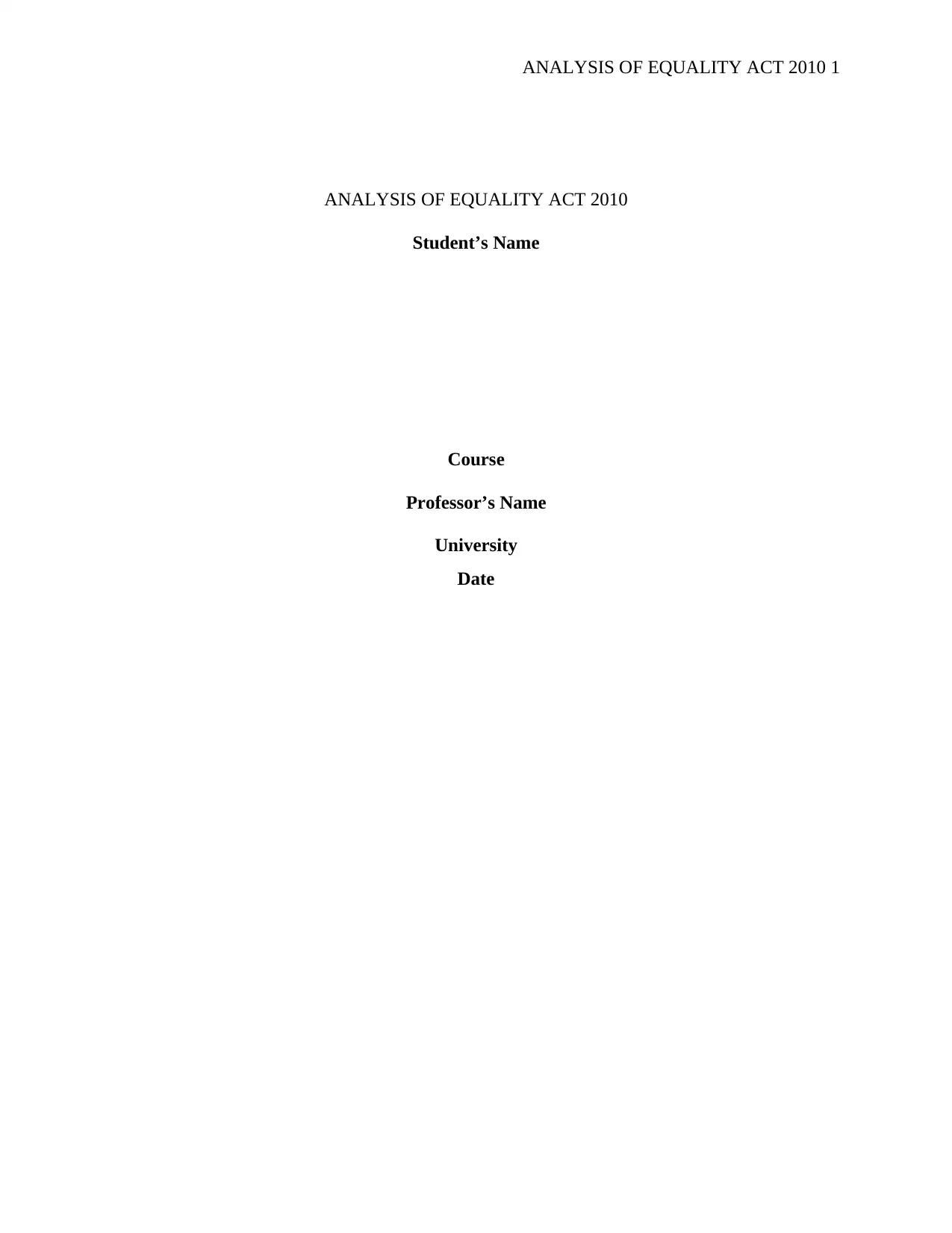
ANALYSIS OF EQUALITY ACT 2010 1
ANALYSIS OF EQUALITY ACT 2010
Student’s Name
Course
Professor’s Name
University
Date
ANALYSIS OF EQUALITY ACT 2010
Student’s Name
Course
Professor’s Name
University
Date
Secure Best Marks with AI Grader
Need help grading? Try our AI Grader for instant feedback on your assignments.
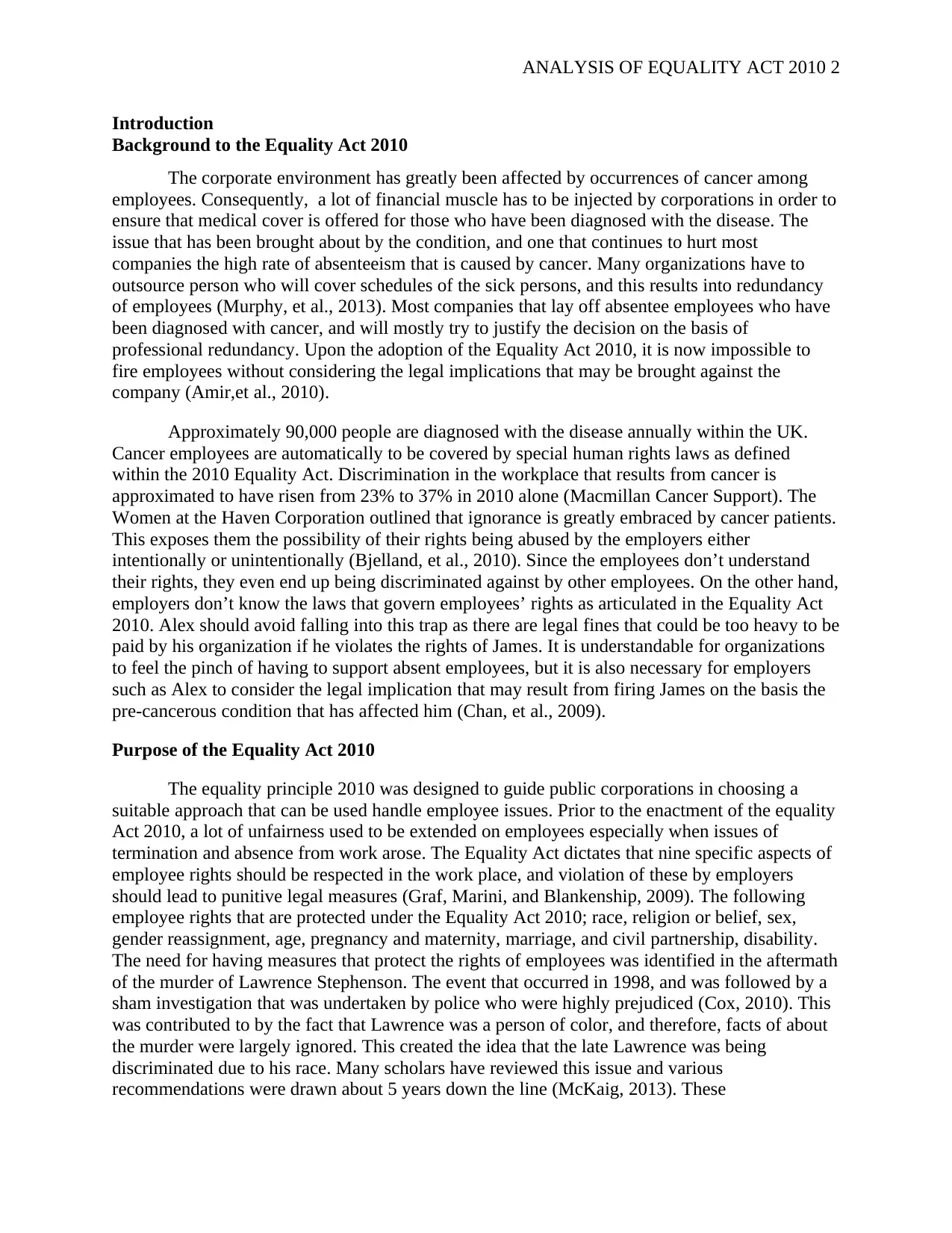
ANALYSIS OF EQUALITY ACT 2010 2
Introduction
Background to the Equality Act 2010
The corporate environment has greatly been affected by occurrences of cancer among
employees. Consequently, a lot of financial muscle has to be injected by corporations in order to
ensure that medical cover is offered for those who have been diagnosed with the disease. The
issue that has been brought about by the condition, and one that continues to hurt most
companies the high rate of absenteeism that is caused by cancer. Many organizations have to
outsource person who will cover schedules of the sick persons, and this results into redundancy
of employees (Murphy, et al., 2013). Most companies that lay off absentee employees who have
been diagnosed with cancer, and will mostly try to justify the decision on the basis of
professional redundancy. Upon the adoption of the Equality Act 2010, it is now impossible to
fire employees without considering the legal implications that may be brought against the
company (Amir,et al., 2010).
Approximately 90,000 people are diagnosed with the disease annually within the UK.
Cancer employees are automatically to be covered by special human rights laws as defined
within the 2010 Equality Act. Discrimination in the workplace that results from cancer is
approximated to have risen from 23% to 37% in 2010 alone (Macmillan Cancer Support). The
Women at the Haven Corporation outlined that ignorance is greatly embraced by cancer patients.
This exposes them the possibility of their rights being abused by the employers either
intentionally or unintentionally (Bjelland, et al., 2010). Since the employees don’t understand
their rights, they even end up being discriminated against by other employees. On the other hand,
employers don’t know the laws that govern employees’ rights as articulated in the Equality Act
2010. Alex should avoid falling into this trap as there are legal fines that could be too heavy to be
paid by his organization if he violates the rights of James. It is understandable for organizations
to feel the pinch of having to support absent employees, but it is also necessary for employers
such as Alex to consider the legal implication that may result from firing James on the basis the
pre-cancerous condition that has affected him (Chan, et al., 2009).
Purpose of the Equality Act 2010
The equality principle 2010 was designed to guide public corporations in choosing a
suitable approach that can be used handle employee issues. Prior to the enactment of the equality
Act 2010, a lot of unfairness used to be extended on employees especially when issues of
termination and absence from work arose. The Equality Act dictates that nine specific aspects of
employee rights should be respected in the work place, and violation of these by employers
should lead to punitive legal measures (Graf, Marini, and Blankenship, 2009). The following
employee rights that are protected under the Equality Act 2010; race, religion or belief, sex,
gender reassignment, age, pregnancy and maternity, marriage, and civil partnership, disability.
The need for having measures that protect the rights of employees was identified in the aftermath
of the murder of Lawrence Stephenson. The event that occurred in 1998, and was followed by a
sham investigation that was undertaken by police who were highly prejudiced (Cox, 2010). This
was contributed to by the fact that Lawrence was a person of color, and therefore, facts of about
the murder were largely ignored. This created the idea that the late Lawrence was being
discriminated due to his race. Many scholars have reviewed this issue and various
recommendations were drawn about 5 years down the line (McKaig, 2013). These
Introduction
Background to the Equality Act 2010
The corporate environment has greatly been affected by occurrences of cancer among
employees. Consequently, a lot of financial muscle has to be injected by corporations in order to
ensure that medical cover is offered for those who have been diagnosed with the disease. The
issue that has been brought about by the condition, and one that continues to hurt most
companies the high rate of absenteeism that is caused by cancer. Many organizations have to
outsource person who will cover schedules of the sick persons, and this results into redundancy
of employees (Murphy, et al., 2013). Most companies that lay off absentee employees who have
been diagnosed with cancer, and will mostly try to justify the decision on the basis of
professional redundancy. Upon the adoption of the Equality Act 2010, it is now impossible to
fire employees without considering the legal implications that may be brought against the
company (Amir,et al., 2010).
Approximately 90,000 people are diagnosed with the disease annually within the UK.
Cancer employees are automatically to be covered by special human rights laws as defined
within the 2010 Equality Act. Discrimination in the workplace that results from cancer is
approximated to have risen from 23% to 37% in 2010 alone (Macmillan Cancer Support). The
Women at the Haven Corporation outlined that ignorance is greatly embraced by cancer patients.
This exposes them the possibility of their rights being abused by the employers either
intentionally or unintentionally (Bjelland, et al., 2010). Since the employees don’t understand
their rights, they even end up being discriminated against by other employees. On the other hand,
employers don’t know the laws that govern employees’ rights as articulated in the Equality Act
2010. Alex should avoid falling into this trap as there are legal fines that could be too heavy to be
paid by his organization if he violates the rights of James. It is understandable for organizations
to feel the pinch of having to support absent employees, but it is also necessary for employers
such as Alex to consider the legal implication that may result from firing James on the basis the
pre-cancerous condition that has affected him (Chan, et al., 2009).
Purpose of the Equality Act 2010
The equality principle 2010 was designed to guide public corporations in choosing a
suitable approach that can be used handle employee issues. Prior to the enactment of the equality
Act 2010, a lot of unfairness used to be extended on employees especially when issues of
termination and absence from work arose. The Equality Act dictates that nine specific aspects of
employee rights should be respected in the work place, and violation of these by employers
should lead to punitive legal measures (Graf, Marini, and Blankenship, 2009). The following
employee rights that are protected under the Equality Act 2010; race, religion or belief, sex,
gender reassignment, age, pregnancy and maternity, marriage, and civil partnership, disability.
The need for having measures that protect the rights of employees was identified in the aftermath
of the murder of Lawrence Stephenson. The event that occurred in 1998, and was followed by a
sham investigation that was undertaken by police who were highly prejudiced (Cox, 2010). This
was contributed to by the fact that Lawrence was a person of color, and therefore, facts of about
the murder were largely ignored. This created the idea that the late Lawrence was being
discriminated due to his race. Many scholars have reviewed this issue and various
recommendations were drawn about 5 years down the line (McKaig, 2013). These
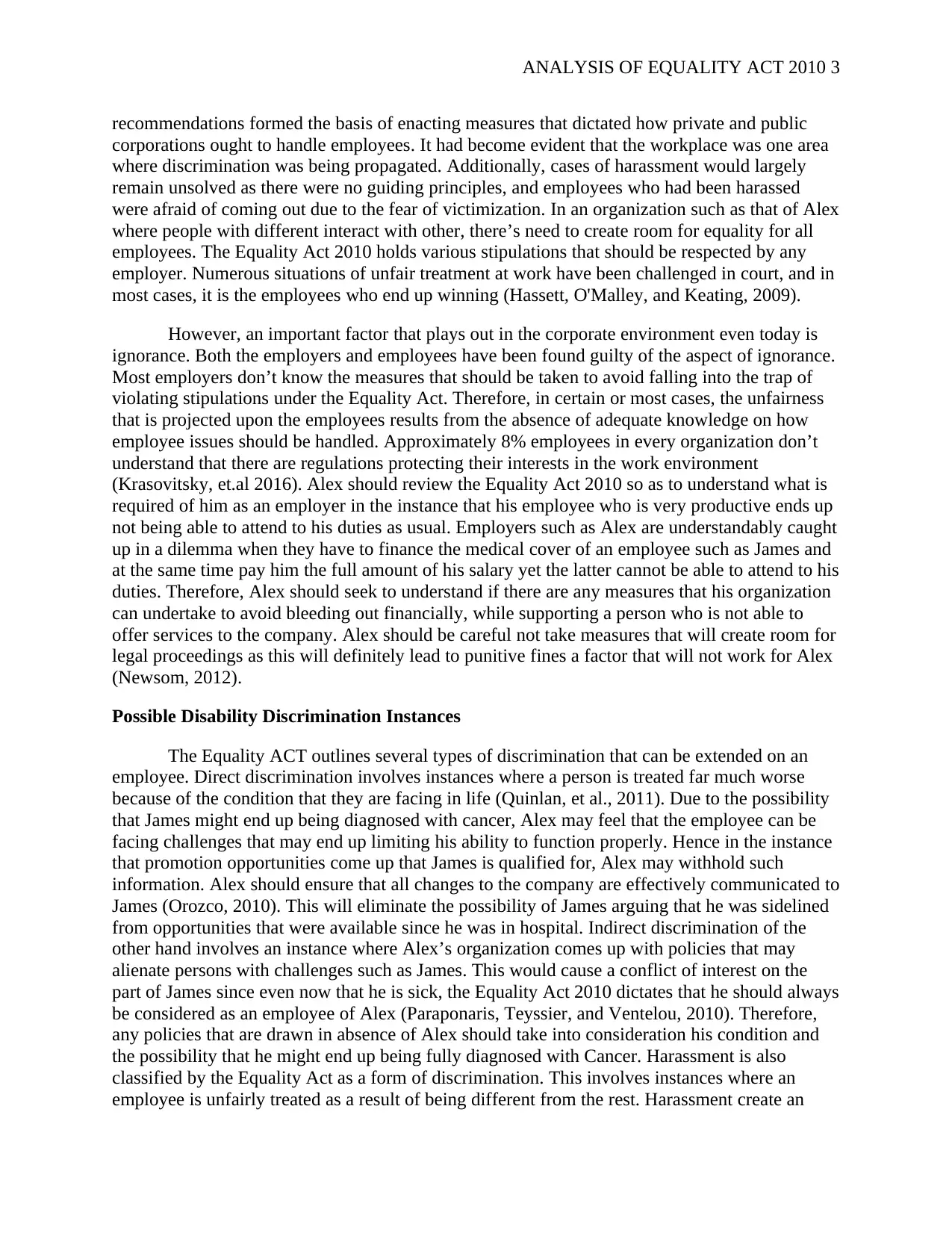
ANALYSIS OF EQUALITY ACT 2010 3
recommendations formed the basis of enacting measures that dictated how private and public
corporations ought to handle employees. It had become evident that the workplace was one area
where discrimination was being propagated. Additionally, cases of harassment would largely
remain unsolved as there were no guiding principles, and employees who had been harassed
were afraid of coming out due to the fear of victimization. In an organization such as that of Alex
where people with different interact with other, there’s need to create room for equality for all
employees. The Equality Act 2010 holds various stipulations that should be respected by any
employer. Numerous situations of unfair treatment at work have been challenged in court, and in
most cases, it is the employees who end up winning (Hassett, O'Malley, and Keating, 2009).
However, an important factor that plays out in the corporate environment even today is
ignorance. Both the employers and employees have been found guilty of the aspect of ignorance.
Most employers don’t know the measures that should be taken to avoid falling into the trap of
violating stipulations under the Equality Act. Therefore, in certain or most cases, the unfairness
that is projected upon the employees results from the absence of adequate knowledge on how
employee issues should be handled. Approximately 8% employees in every organization don’t
understand that there are regulations protecting their interests in the work environment
(Krasovitsky, et.al 2016). Alex should review the Equality Act 2010 so as to understand what is
required of him as an employer in the instance that his employee who is very productive ends up
not being able to attend to his duties as usual. Employers such as Alex are understandably caught
up in a dilemma when they have to finance the medical cover of an employee such as James and
at the same time pay him the full amount of his salary yet the latter cannot be able to attend to his
duties. Therefore, Alex should seek to understand if there are any measures that his organization
can undertake to avoid bleeding out financially, while supporting a person who is not able to
offer services to the company. Alex should be careful not take measures that will create room for
legal proceedings as this will definitely lead to punitive fines a factor that will not work for Alex
(Newsom, 2012).
Possible Disability Discrimination Instances
The Equality ACT outlines several types of discrimination that can be extended on an
employee. Direct discrimination involves instances where a person is treated far much worse
because of the condition that they are facing in life (Quinlan, et al., 2011). Due to the possibility
that James might end up being diagnosed with cancer, Alex may feel that the employee can be
facing challenges that may end up limiting his ability to function properly. Hence in the instance
that promotion opportunities come up that James is qualified for, Alex may withhold such
information. Alex should ensure that all changes to the company are effectively communicated to
James (Orozco, 2010). This will eliminate the possibility of James arguing that he was sidelined
from opportunities that were available since he was in hospital. Indirect discrimination of the
other hand involves an instance where Alex’s organization comes up with policies that may
alienate persons with challenges such as James. This would cause a conflict of interest on the
part of James since even now that he is sick, the Equality Act 2010 dictates that he should always
be considered as an employee of Alex (Paraponaris, Teyssier, and Ventelou, 2010). Therefore,
any policies that are drawn in absence of Alex should take into consideration his condition and
the possibility that he might end up being fully diagnosed with Cancer. Harassment is also
classified by the Equality Act as a form of discrimination. This involves instances where an
employee is unfairly treated as a result of being different from the rest. Harassment create an
recommendations formed the basis of enacting measures that dictated how private and public
corporations ought to handle employees. It had become evident that the workplace was one area
where discrimination was being propagated. Additionally, cases of harassment would largely
remain unsolved as there were no guiding principles, and employees who had been harassed
were afraid of coming out due to the fear of victimization. In an organization such as that of Alex
where people with different interact with other, there’s need to create room for equality for all
employees. The Equality Act 2010 holds various stipulations that should be respected by any
employer. Numerous situations of unfair treatment at work have been challenged in court, and in
most cases, it is the employees who end up winning (Hassett, O'Malley, and Keating, 2009).
However, an important factor that plays out in the corporate environment even today is
ignorance. Both the employers and employees have been found guilty of the aspect of ignorance.
Most employers don’t know the measures that should be taken to avoid falling into the trap of
violating stipulations under the Equality Act. Therefore, in certain or most cases, the unfairness
that is projected upon the employees results from the absence of adequate knowledge on how
employee issues should be handled. Approximately 8% employees in every organization don’t
understand that there are regulations protecting their interests in the work environment
(Krasovitsky, et.al 2016). Alex should review the Equality Act 2010 so as to understand what is
required of him as an employer in the instance that his employee who is very productive ends up
not being able to attend to his duties as usual. Employers such as Alex are understandably caught
up in a dilemma when they have to finance the medical cover of an employee such as James and
at the same time pay him the full amount of his salary yet the latter cannot be able to attend to his
duties. Therefore, Alex should seek to understand if there are any measures that his organization
can undertake to avoid bleeding out financially, while supporting a person who is not able to
offer services to the company. Alex should be careful not take measures that will create room for
legal proceedings as this will definitely lead to punitive fines a factor that will not work for Alex
(Newsom, 2012).
Possible Disability Discrimination Instances
The Equality ACT outlines several types of discrimination that can be extended on an
employee. Direct discrimination involves instances where a person is treated far much worse
because of the condition that they are facing in life (Quinlan, et al., 2011). Due to the possibility
that James might end up being diagnosed with cancer, Alex may feel that the employee can be
facing challenges that may end up limiting his ability to function properly. Hence in the instance
that promotion opportunities come up that James is qualified for, Alex may withhold such
information. Alex should ensure that all changes to the company are effectively communicated to
James (Orozco, 2010). This will eliminate the possibility of James arguing that he was sidelined
from opportunities that were available since he was in hospital. Indirect discrimination of the
other hand involves an instance where Alex’s organization comes up with policies that may
alienate persons with challenges such as James. This would cause a conflict of interest on the
part of James since even now that he is sick, the Equality Act 2010 dictates that he should always
be considered as an employee of Alex (Paraponaris, Teyssier, and Ventelou, 2010). Therefore,
any policies that are drawn in absence of Alex should take into consideration his condition and
the possibility that he might end up being fully diagnosed with Cancer. Harassment is also
classified by the Equality Act as a form of discrimination. This involves instances where an
employee is unfairly treated as a result of being different from the rest. Harassment create an
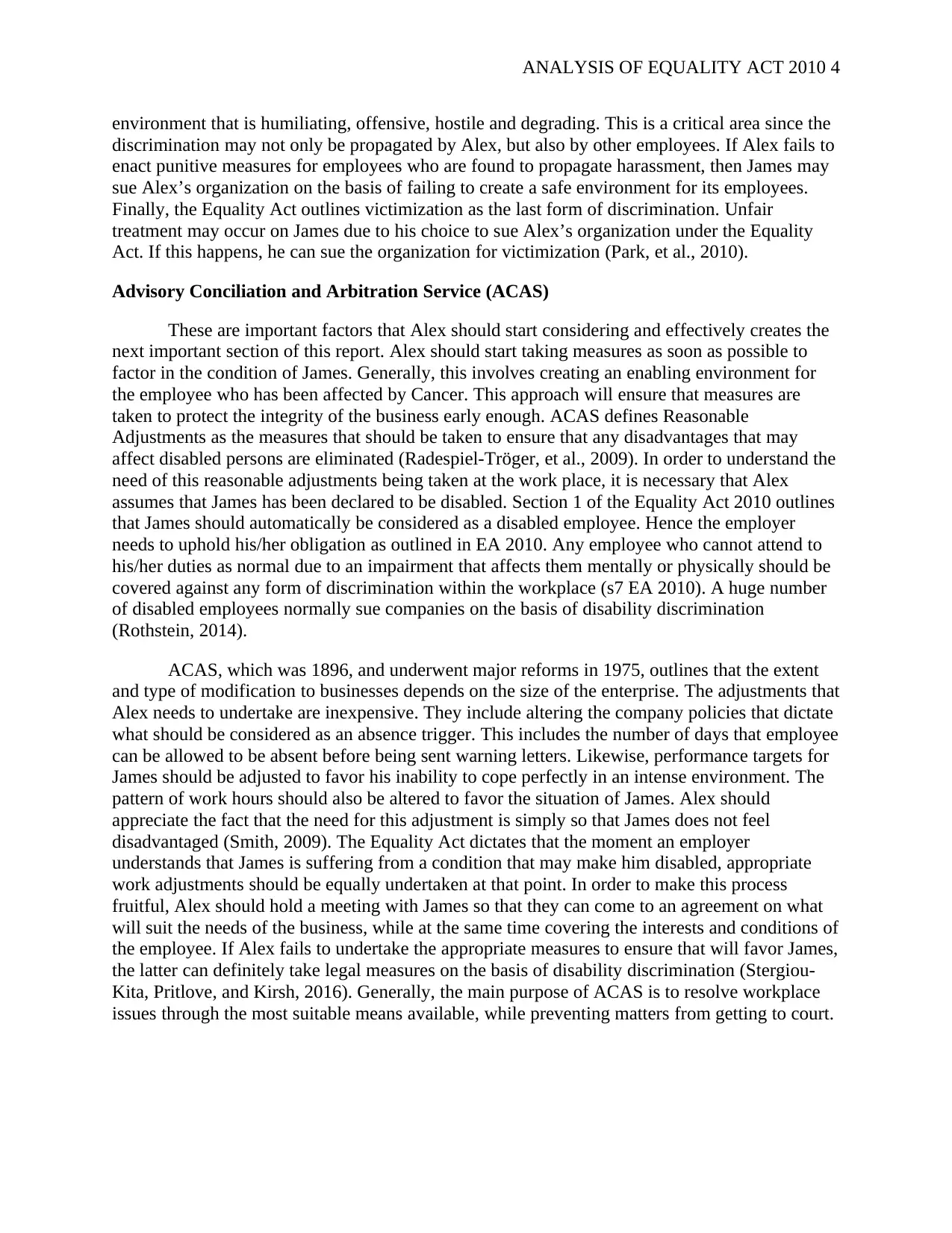
ANALYSIS OF EQUALITY ACT 2010 4
environment that is humiliating, offensive, hostile and degrading. This is a critical area since the
discrimination may not only be propagated by Alex, but also by other employees. If Alex fails to
enact punitive measures for employees who are found to propagate harassment, then James may
sue Alex’s organization on the basis of failing to create a safe environment for its employees.
Finally, the Equality Act outlines victimization as the last form of discrimination. Unfair
treatment may occur on James due to his choice to sue Alex’s organization under the Equality
Act. If this happens, he can sue the organization for victimization (Park, et al., 2010).
Advisory Conciliation and Arbitration Service (ACAS)
These are important factors that Alex should start considering and effectively creates the
next important section of this report. Alex should start taking measures as soon as possible to
factor in the condition of James. Generally, this involves creating an enabling environment for
the employee who has been affected by Cancer. This approach will ensure that measures are
taken to protect the integrity of the business early enough. ACAS defines Reasonable
Adjustments as the measures that should be taken to ensure that any disadvantages that may
affect disabled persons are eliminated (Radespiel-Tröger, et al., 2009). In order to understand the
need of this reasonable adjustments being taken at the work place, it is necessary that Alex
assumes that James has been declared to be disabled. Section 1 of the Equality Act 2010 outlines
that James should automatically be considered as a disabled employee. Hence the employer
needs to uphold his/her obligation as outlined in EA 2010. Any employee who cannot attend to
his/her duties as normal due to an impairment that affects them mentally or physically should be
covered against any form of discrimination within the workplace (s7 EA 2010). A huge number
of disabled employees normally sue companies on the basis of disability discrimination
(Rothstein, 2014).
ACAS, which was 1896, and underwent major reforms in 1975, outlines that the extent
and type of modification to businesses depends on the size of the enterprise. The adjustments that
Alex needs to undertake are inexpensive. They include altering the company policies that dictate
what should be considered as an absence trigger. This includes the number of days that employee
can be allowed to be absent before being sent warning letters. Likewise, performance targets for
James should be adjusted to favor his inability to cope perfectly in an intense environment. The
pattern of work hours should also be altered to favor the situation of James. Alex should
appreciate the fact that the need for this adjustment is simply so that James does not feel
disadvantaged (Smith, 2009). The Equality Act dictates that the moment an employer
understands that James is suffering from a condition that may make him disabled, appropriate
work adjustments should be equally undertaken at that point. In order to make this process
fruitful, Alex should hold a meeting with James so that they can come to an agreement on what
will suit the needs of the business, while at the same time covering the interests and conditions of
the employee. If Alex fails to undertake the appropriate measures to ensure that will favor James,
the latter can definitely take legal measures on the basis of disability discrimination (Stergiou-
Kita, Pritlove, and Kirsh, 2016). Generally, the main purpose of ACAS is to resolve workplace
issues through the most suitable means available, while preventing matters from getting to court.
environment that is humiliating, offensive, hostile and degrading. This is a critical area since the
discrimination may not only be propagated by Alex, but also by other employees. If Alex fails to
enact punitive measures for employees who are found to propagate harassment, then James may
sue Alex’s organization on the basis of failing to create a safe environment for its employees.
Finally, the Equality Act outlines victimization as the last form of discrimination. Unfair
treatment may occur on James due to his choice to sue Alex’s organization under the Equality
Act. If this happens, he can sue the organization for victimization (Park, et al., 2010).
Advisory Conciliation and Arbitration Service (ACAS)
These are important factors that Alex should start considering and effectively creates the
next important section of this report. Alex should start taking measures as soon as possible to
factor in the condition of James. Generally, this involves creating an enabling environment for
the employee who has been affected by Cancer. This approach will ensure that measures are
taken to protect the integrity of the business early enough. ACAS defines Reasonable
Adjustments as the measures that should be taken to ensure that any disadvantages that may
affect disabled persons are eliminated (Radespiel-Tröger, et al., 2009). In order to understand the
need of this reasonable adjustments being taken at the work place, it is necessary that Alex
assumes that James has been declared to be disabled. Section 1 of the Equality Act 2010 outlines
that James should automatically be considered as a disabled employee. Hence the employer
needs to uphold his/her obligation as outlined in EA 2010. Any employee who cannot attend to
his/her duties as normal due to an impairment that affects them mentally or physically should be
covered against any form of discrimination within the workplace (s7 EA 2010). A huge number
of disabled employees normally sue companies on the basis of disability discrimination
(Rothstein, 2014).
ACAS, which was 1896, and underwent major reforms in 1975, outlines that the extent
and type of modification to businesses depends on the size of the enterprise. The adjustments that
Alex needs to undertake are inexpensive. They include altering the company policies that dictate
what should be considered as an absence trigger. This includes the number of days that employee
can be allowed to be absent before being sent warning letters. Likewise, performance targets for
James should be adjusted to favor his inability to cope perfectly in an intense environment. The
pattern of work hours should also be altered to favor the situation of James. Alex should
appreciate the fact that the need for this adjustment is simply so that James does not feel
disadvantaged (Smith, 2009). The Equality Act dictates that the moment an employer
understands that James is suffering from a condition that may make him disabled, appropriate
work adjustments should be equally undertaken at that point. In order to make this process
fruitful, Alex should hold a meeting with James so that they can come to an agreement on what
will suit the needs of the business, while at the same time covering the interests and conditions of
the employee. If Alex fails to undertake the appropriate measures to ensure that will favor James,
the latter can definitely take legal measures on the basis of disability discrimination (Stergiou-
Kita, Pritlove, and Kirsh, 2016). Generally, the main purpose of ACAS is to resolve workplace
issues through the most suitable means available, while preventing matters from getting to court.
Secure Best Marks with AI Grader
Need help grading? Try our AI Grader for instant feedback on your assignments.
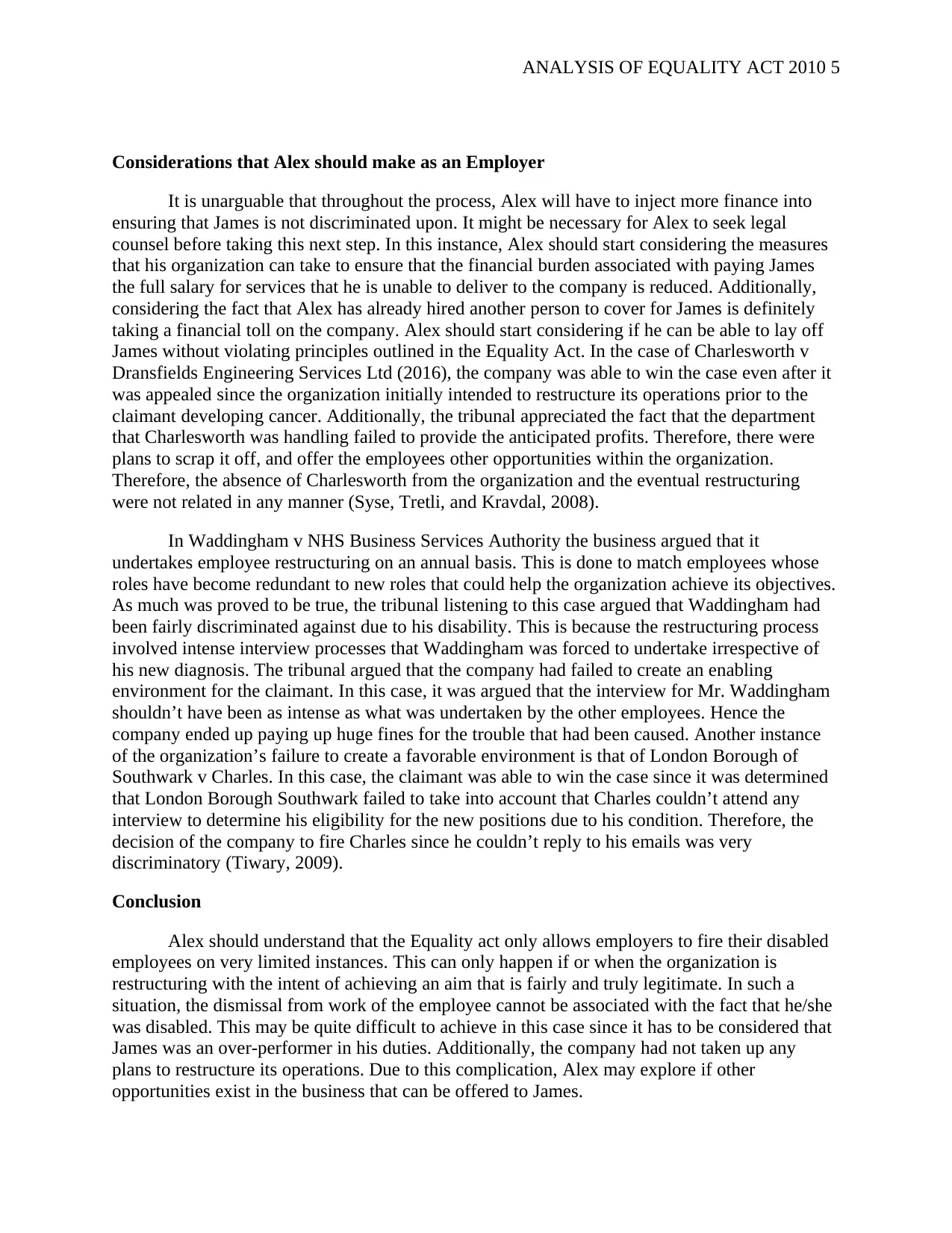
ANALYSIS OF EQUALITY ACT 2010 5
Considerations that Alex should make as an Employer
It is unarguable that throughout the process, Alex will have to inject more finance into
ensuring that James is not discriminated upon. It might be necessary for Alex to seek legal
counsel before taking this next step. In this instance, Alex should start considering the measures
that his organization can take to ensure that the financial burden associated with paying James
the full salary for services that he is unable to deliver to the company is reduced. Additionally,
considering the fact that Alex has already hired another person to cover for James is definitely
taking a financial toll on the company. Alex should start considering if he can be able to lay off
James without violating principles outlined in the Equality Act. In the case of Charlesworth v
Dransfields Engineering Services Ltd (2016), the company was able to win the case even after it
was appealed since the organization initially intended to restructure its operations prior to the
claimant developing cancer. Additionally, the tribunal appreciated the fact that the department
that Charlesworth was handling failed to provide the anticipated profits. Therefore, there were
plans to scrap it off, and offer the employees other opportunities within the organization.
Therefore, the absence of Charlesworth from the organization and the eventual restructuring
were not related in any manner (Syse, Tretli, and Kravdal, 2008).
In Waddingham v NHS Business Services Authority the business argued that it
undertakes employee restructuring on an annual basis. This is done to match employees whose
roles have become redundant to new roles that could help the organization achieve its objectives.
As much was proved to be true, the tribunal listening to this case argued that Waddingham had
been fairly discriminated against due to his disability. This is because the restructuring process
involved intense interview processes that Waddingham was forced to undertake irrespective of
his new diagnosis. The tribunal argued that the company had failed to create an enabling
environment for the claimant. In this case, it was argued that the interview for Mr. Waddingham
shouldn’t have been as intense as what was undertaken by the other employees. Hence the
company ended up paying up huge fines for the trouble that had been caused. Another instance
of the organization’s failure to create a favorable environment is that of London Borough of
Southwark v Charles. In this case, the claimant was able to win the case since it was determined
that London Borough Southwark failed to take into account that Charles couldn’t attend any
interview to determine his eligibility for the new positions due to his condition. Therefore, the
decision of the company to fire Charles since he couldn’t reply to his emails was very
discriminatory (Tiwary, 2009).
Conclusion
Alex should understand that the Equality act only allows employers to fire their disabled
employees on very limited instances. This can only happen if or when the organization is
restructuring with the intent of achieving an aim that is fairly and truly legitimate. In such a
situation, the dismissal from work of the employee cannot be associated with the fact that he/she
was disabled. This may be quite difficult to achieve in this case since it has to be considered that
James was an over-performer in his duties. Additionally, the company had not taken up any
plans to restructure its operations. Due to this complication, Alex may explore if other
opportunities exist in the business that can be offered to James.
Considerations that Alex should make as an Employer
It is unarguable that throughout the process, Alex will have to inject more finance into
ensuring that James is not discriminated upon. It might be necessary for Alex to seek legal
counsel before taking this next step. In this instance, Alex should start considering the measures
that his organization can take to ensure that the financial burden associated with paying James
the full salary for services that he is unable to deliver to the company is reduced. Additionally,
considering the fact that Alex has already hired another person to cover for James is definitely
taking a financial toll on the company. Alex should start considering if he can be able to lay off
James without violating principles outlined in the Equality Act. In the case of Charlesworth v
Dransfields Engineering Services Ltd (2016), the company was able to win the case even after it
was appealed since the organization initially intended to restructure its operations prior to the
claimant developing cancer. Additionally, the tribunal appreciated the fact that the department
that Charlesworth was handling failed to provide the anticipated profits. Therefore, there were
plans to scrap it off, and offer the employees other opportunities within the organization.
Therefore, the absence of Charlesworth from the organization and the eventual restructuring
were not related in any manner (Syse, Tretli, and Kravdal, 2008).
In Waddingham v NHS Business Services Authority the business argued that it
undertakes employee restructuring on an annual basis. This is done to match employees whose
roles have become redundant to new roles that could help the organization achieve its objectives.
As much was proved to be true, the tribunal listening to this case argued that Waddingham had
been fairly discriminated against due to his disability. This is because the restructuring process
involved intense interview processes that Waddingham was forced to undertake irrespective of
his new diagnosis. The tribunal argued that the company had failed to create an enabling
environment for the claimant. In this case, it was argued that the interview for Mr. Waddingham
shouldn’t have been as intense as what was undertaken by the other employees. Hence the
company ended up paying up huge fines for the trouble that had been caused. Another instance
of the organization’s failure to create a favorable environment is that of London Borough of
Southwark v Charles. In this case, the claimant was able to win the case since it was determined
that London Borough Southwark failed to take into account that Charles couldn’t attend any
interview to determine his eligibility for the new positions due to his condition. Therefore, the
decision of the company to fire Charles since he couldn’t reply to his emails was very
discriminatory (Tiwary, 2009).
Conclusion
Alex should understand that the Equality act only allows employers to fire their disabled
employees on very limited instances. This can only happen if or when the organization is
restructuring with the intent of achieving an aim that is fairly and truly legitimate. In such a
situation, the dismissal from work of the employee cannot be associated with the fact that he/she
was disabled. This may be quite difficult to achieve in this case since it has to be considered that
James was an over-performer in his duties. Additionally, the company had not taken up any
plans to restructure its operations. Due to this complication, Alex may explore if other
opportunities exist in the business that can be offered to James.

ANALYSIS OF EQUALITY ACT 2010 6
When and if James is diagnosed with Cancer, Alex should talk to James when he is in a capacity
to make conscious decisions. Alex should offer him a less strenuous position that will not create
further health complications on the health of James. If James agrees to this proposal, then he will
remain in the company where he will be given a medical cover and continue to receive half of his
salary. Optionally, Alex can restructure the company and offer James with a new position in
which there a fewer tasks involved. The interview should be conducted with the consideration of
the disability that is affecting James. In this case his performance should be analyzed with a
lower target set for him.
When and if James is diagnosed with Cancer, Alex should talk to James when he is in a capacity
to make conscious decisions. Alex should offer him a less strenuous position that will not create
further health complications on the health of James. If James agrees to this proposal, then he will
remain in the company where he will be given a medical cover and continue to receive half of his
salary. Optionally, Alex can restructure the company and offer James with a new position in
which there a fewer tasks involved. The interview should be conducted with the consideration of
the disability that is affecting James. In this case his performance should be analyzed with a
lower target set for him.
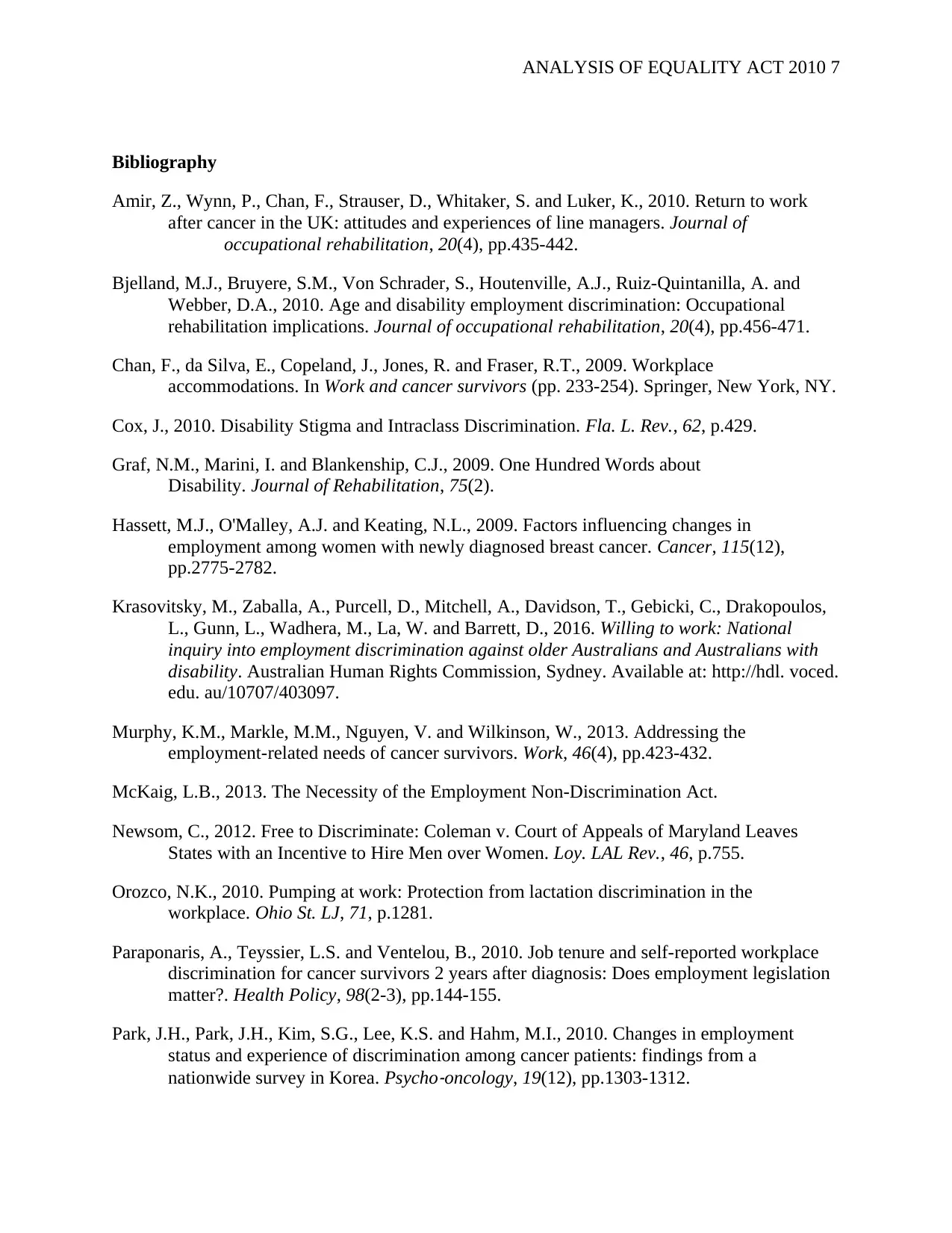
ANALYSIS OF EQUALITY ACT 2010 7
Bibliography
Amir, Z., Wynn, P., Chan, F., Strauser, D., Whitaker, S. and Luker, K., 2010. Return to work
after cancer in the UK: attitudes and experiences of line managers. Journal of
occupational rehabilitation, 20(4), pp.435-442.
Bjelland, M.J., Bruyere, S.M., Von Schrader, S., Houtenville, A.J., Ruiz-Quintanilla, A. and
Webber, D.A., 2010. Age and disability employment discrimination: Occupational
rehabilitation implications. Journal of occupational rehabilitation, 20(4), pp.456-471.
Chan, F., da Silva, E., Copeland, J., Jones, R. and Fraser, R.T., 2009. Workplace
accommodations. In Work and cancer survivors (pp. 233-254). Springer, New York, NY.
Cox, J., 2010. Disability Stigma and Intraclass Discrimination. Fla. L. Rev., 62, p.429.
Graf, N.M., Marini, I. and Blankenship, C.J., 2009. One Hundred Words about
Disability. Journal of Rehabilitation, 75(2).
Hassett, M.J., O'Malley, A.J. and Keating, N.L., 2009. Factors influencing changes in
employment among women with newly diagnosed breast cancer. Cancer, 115(12),
pp.2775-2782.
Krasovitsky, M., Zaballa, A., Purcell, D., Mitchell, A., Davidson, T., Gebicki, C., Drakopoulos,
L., Gunn, L., Wadhera, M., La, W. and Barrett, D., 2016. Willing to work: National
inquiry into employment discrimination against older Australians and Australians with
disability. Australian Human Rights Commission, Sydney. Available at: http://hdl. voced.
edu. au/10707/403097.
Murphy, K.M., Markle, M.M., Nguyen, V. and Wilkinson, W., 2013. Addressing the
employment-related needs of cancer survivors. Work, 46(4), pp.423-432.
McKaig, L.B., 2013. The Necessity of the Employment Non-Discrimination Act.
Newsom, C., 2012. Free to Discriminate: Coleman v. Court of Appeals of Maryland Leaves
States with an Incentive to Hire Men over Women. Loy. LAL Rev., 46, p.755.
Orozco, N.K., 2010. Pumping at work: Protection from lactation discrimination in the
workplace. Ohio St. LJ, 71, p.1281.
Paraponaris, A., Teyssier, L.S. and Ventelou, B., 2010. Job tenure and self-reported workplace
discrimination for cancer survivors 2 years after diagnosis: Does employment legislation
matter?. Health Policy, 98(2-3), pp.144-155.
Park, J.H., Park, J.H., Kim, S.G., Lee, K.S. and Hahm, M.I., 2010. Changes in employment
status and experience of discrimination among cancer patients: findings from a
nationwide survey in Korea. Psycho
‐oncology, 19(12), pp.1303-1312.
Bibliography
Amir, Z., Wynn, P., Chan, F., Strauser, D., Whitaker, S. and Luker, K., 2010. Return to work
after cancer in the UK: attitudes and experiences of line managers. Journal of
occupational rehabilitation, 20(4), pp.435-442.
Bjelland, M.J., Bruyere, S.M., Von Schrader, S., Houtenville, A.J., Ruiz-Quintanilla, A. and
Webber, D.A., 2010. Age and disability employment discrimination: Occupational
rehabilitation implications. Journal of occupational rehabilitation, 20(4), pp.456-471.
Chan, F., da Silva, E., Copeland, J., Jones, R. and Fraser, R.T., 2009. Workplace
accommodations. In Work and cancer survivors (pp. 233-254). Springer, New York, NY.
Cox, J., 2010. Disability Stigma and Intraclass Discrimination. Fla. L. Rev., 62, p.429.
Graf, N.M., Marini, I. and Blankenship, C.J., 2009. One Hundred Words about
Disability. Journal of Rehabilitation, 75(2).
Hassett, M.J., O'Malley, A.J. and Keating, N.L., 2009. Factors influencing changes in
employment among women with newly diagnosed breast cancer. Cancer, 115(12),
pp.2775-2782.
Krasovitsky, M., Zaballa, A., Purcell, D., Mitchell, A., Davidson, T., Gebicki, C., Drakopoulos,
L., Gunn, L., Wadhera, M., La, W. and Barrett, D., 2016. Willing to work: National
inquiry into employment discrimination against older Australians and Australians with
disability. Australian Human Rights Commission, Sydney. Available at: http://hdl. voced.
edu. au/10707/403097.
Murphy, K.M., Markle, M.M., Nguyen, V. and Wilkinson, W., 2013. Addressing the
employment-related needs of cancer survivors. Work, 46(4), pp.423-432.
McKaig, L.B., 2013. The Necessity of the Employment Non-Discrimination Act.
Newsom, C., 2012. Free to Discriminate: Coleman v. Court of Appeals of Maryland Leaves
States with an Incentive to Hire Men over Women. Loy. LAL Rev., 46, p.755.
Orozco, N.K., 2010. Pumping at work: Protection from lactation discrimination in the
workplace. Ohio St. LJ, 71, p.1281.
Paraponaris, A., Teyssier, L.S. and Ventelou, B., 2010. Job tenure and self-reported workplace
discrimination for cancer survivors 2 years after diagnosis: Does employment legislation
matter?. Health Policy, 98(2-3), pp.144-155.
Park, J.H., Park, J.H., Kim, S.G., Lee, K.S. and Hahm, M.I., 2010. Changes in employment
status and experience of discrimination among cancer patients: findings from a
nationwide survey in Korea. Psycho
‐oncology, 19(12), pp.1303-1312.
Paraphrase This Document
Need a fresh take? Get an instant paraphrase of this document with our AI Paraphraser
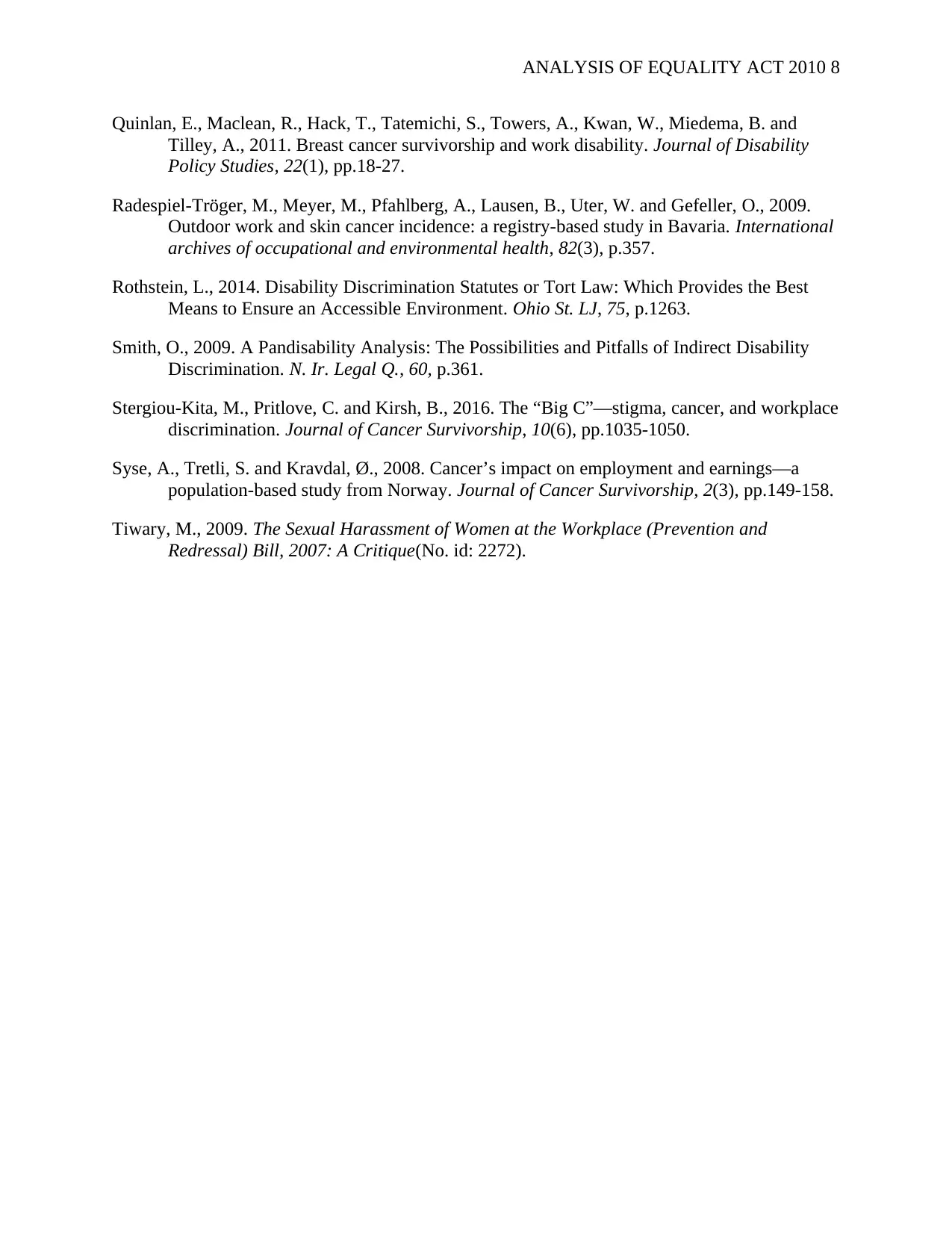
ANALYSIS OF EQUALITY ACT 2010 8
Quinlan, E., Maclean, R., Hack, T., Tatemichi, S., Towers, A., Kwan, W., Miedema, B. and
Tilley, A., 2011. Breast cancer survivorship and work disability. Journal of Disability
Policy Studies, 22(1), pp.18-27.
Radespiel-Tröger, M., Meyer, M., Pfahlberg, A., Lausen, B., Uter, W. and Gefeller, O., 2009.
Outdoor work and skin cancer incidence: a registry-based study in Bavaria. International
archives of occupational and environmental health, 82(3), p.357.
Rothstein, L., 2014. Disability Discrimination Statutes or Tort Law: Which Provides the Best
Means to Ensure an Accessible Environment. Ohio St. LJ, 75, p.1263.
Smith, O., 2009. A Pandisability Analysis: The Possibilities and Pitfalls of Indirect Disability
Discrimination. N. Ir. Legal Q., 60, p.361.
Stergiou-Kita, M., Pritlove, C. and Kirsh, B., 2016. The “Big C”—stigma, cancer, and workplace
discrimination. Journal of Cancer Survivorship, 10(6), pp.1035-1050.
Syse, A., Tretli, S. and Kravdal, Ø., 2008. Cancer’s impact on employment and earnings—a
population-based study from Norway. Journal of Cancer Survivorship, 2(3), pp.149-158.
Tiwary, M., 2009. The Sexual Harassment of Women at the Workplace (Prevention and
Redressal) Bill, 2007: A Critique(No. id: 2272).
Quinlan, E., Maclean, R., Hack, T., Tatemichi, S., Towers, A., Kwan, W., Miedema, B. and
Tilley, A., 2011. Breast cancer survivorship and work disability. Journal of Disability
Policy Studies, 22(1), pp.18-27.
Radespiel-Tröger, M., Meyer, M., Pfahlberg, A., Lausen, B., Uter, W. and Gefeller, O., 2009.
Outdoor work and skin cancer incidence: a registry-based study in Bavaria. International
archives of occupational and environmental health, 82(3), p.357.
Rothstein, L., 2014. Disability Discrimination Statutes or Tort Law: Which Provides the Best
Means to Ensure an Accessible Environment. Ohio St. LJ, 75, p.1263.
Smith, O., 2009. A Pandisability Analysis: The Possibilities and Pitfalls of Indirect Disability
Discrimination. N. Ir. Legal Q., 60, p.361.
Stergiou-Kita, M., Pritlove, C. and Kirsh, B., 2016. The “Big C”—stigma, cancer, and workplace
discrimination. Journal of Cancer Survivorship, 10(6), pp.1035-1050.
Syse, A., Tretli, S. and Kravdal, Ø., 2008. Cancer’s impact on employment and earnings—a
population-based study from Norway. Journal of Cancer Survivorship, 2(3), pp.149-158.
Tiwary, M., 2009. The Sexual Harassment of Women at the Workplace (Prevention and
Redressal) Bill, 2007: A Critique(No. id: 2272).
1 out of 8
Your All-in-One AI-Powered Toolkit for Academic Success.
+13062052269
info@desklib.com
Available 24*7 on WhatsApp / Email
![[object Object]](/_next/static/media/star-bottom.7253800d.svg)
Unlock your academic potential
© 2024 | Zucol Services PVT LTD | All rights reserved.


